Scottish football is a lovable, entertaining mess. From profiling, in terms of passing, as stylistically comparable to the lower reaches of English football to Hibernian's head scratching statement that manager Neil Lennon had left the club but 'had not been dismissed and had not resigned'; from the flagship highlights show airing in the wee hours and featuring a pundit known for stating in an interview that he doesn't actually like watching football to the almost one hundred incomings and the almost one hundred outgoings shared among just twelve top flight teams in the January transfer window; from the four penalties given for one team in one match to the subsequent obsessive speculation about our footballing officials' tribal loyalties, Scotland has it all. Believe it or not, underneath the confusing, distracting loud noises and divisive narratives, it also has some football happening. Let's attempt to make sense of three big stories from the Scottish Premiership.
What Happened To The Edinburgh Title Challenge?
At the time of our week eight review of the Scottish Premiership Heart of Midlothian and Hibernian held the top two positions in the league. That article did point out this might not last and the Edinburgh clubs have since slipped down the table to fifth and eighth respectively. In that period Hearts struggled due to injury to several key players and Hibs seemed to stutter in front of goal with then manager Neil Lennon repeatedly questioning center forward Florian Kamberi's commitment. What actually changed for both clubs? 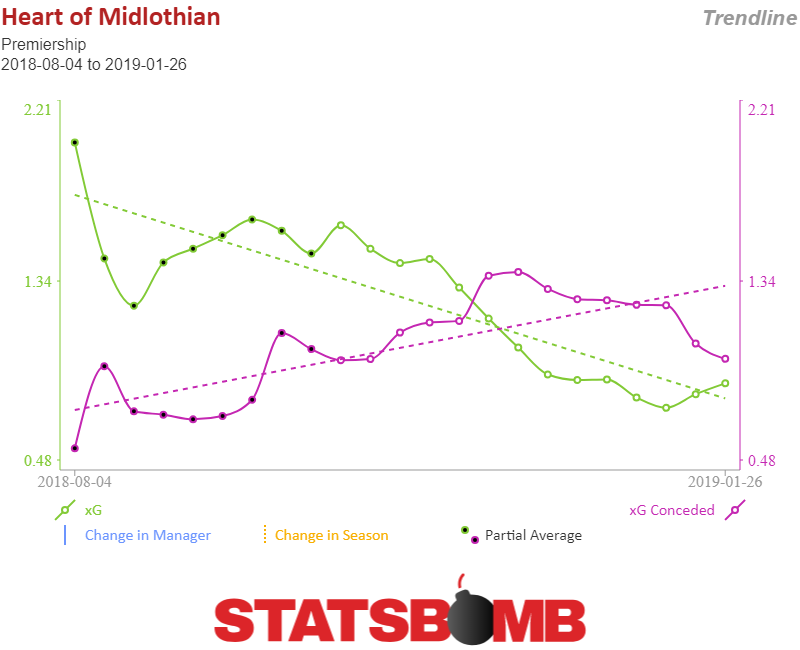 Hearts had a spell from the start of November to Christmas Day during which they lost six of eight games and two of those defeats were by 5-0 scorelines. As noted this was a period when their squad was depleted. Injuries to center back pairing Christophe Berra and John Souttar robbed them of a complementary duo as both can deal with high balls and the former contributes aggressive clearances while the latter can seek out teammates with good long balls. Uche Ikpeazu finally returned to first team action this week and his high volume of shooting, dribbling and aerial wins has been missed. Steven Naismith was out for eight league matches and he was a loss for his goal threat and ability to set standards for others. Since the eight week marker Hearts are taking fewer shots and, although when they do shoot they're now doing it from slightly higher xG situations, they are generating less xG per match on average. Their underlying numbers have been heading in worrying directions at both ends of the pitch.
Hearts had a spell from the start of November to Christmas Day during which they lost six of eight games and two of those defeats were by 5-0 scorelines. As noted this was a period when their squad was depleted. Injuries to center back pairing Christophe Berra and John Souttar robbed them of a complementary duo as both can deal with high balls and the former contributes aggressive clearances while the latter can seek out teammates with good long balls. Uche Ikpeazu finally returned to first team action this week and his high volume of shooting, dribbling and aerial wins has been missed. Steven Naismith was out for eight league matches and he was a loss for his goal threat and ability to set standards for others. Since the eight week marker Hearts are taking fewer shots and, although when they do shoot they're now doing it from slightly higher xG situations, they are generating less xG per match on average. Their underlying numbers have been heading in worrying directions at both ends of the pitch. 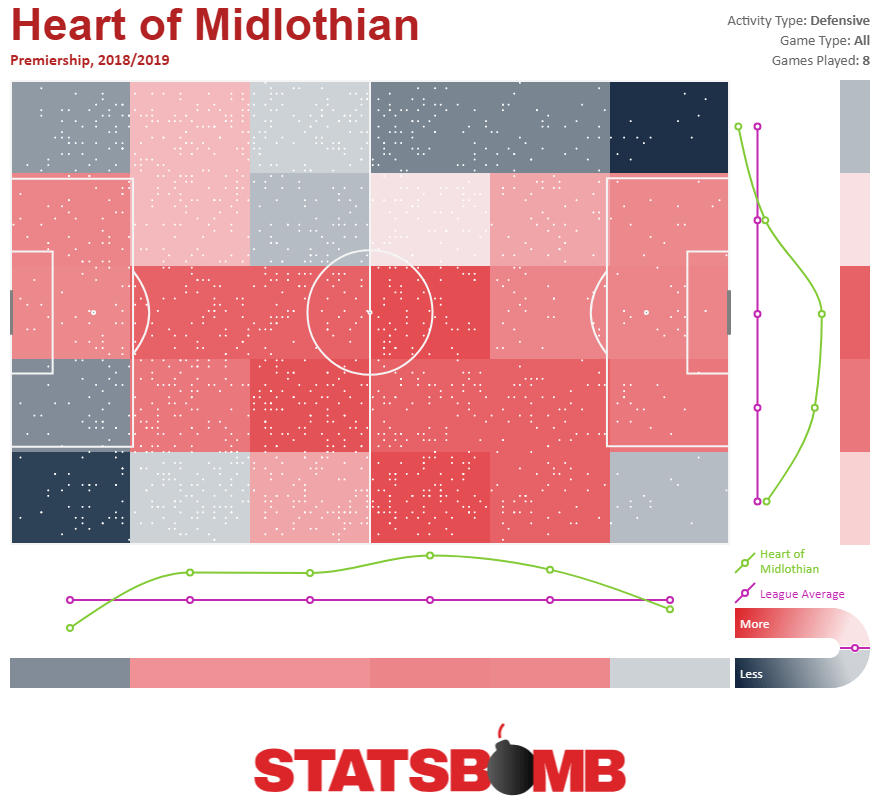
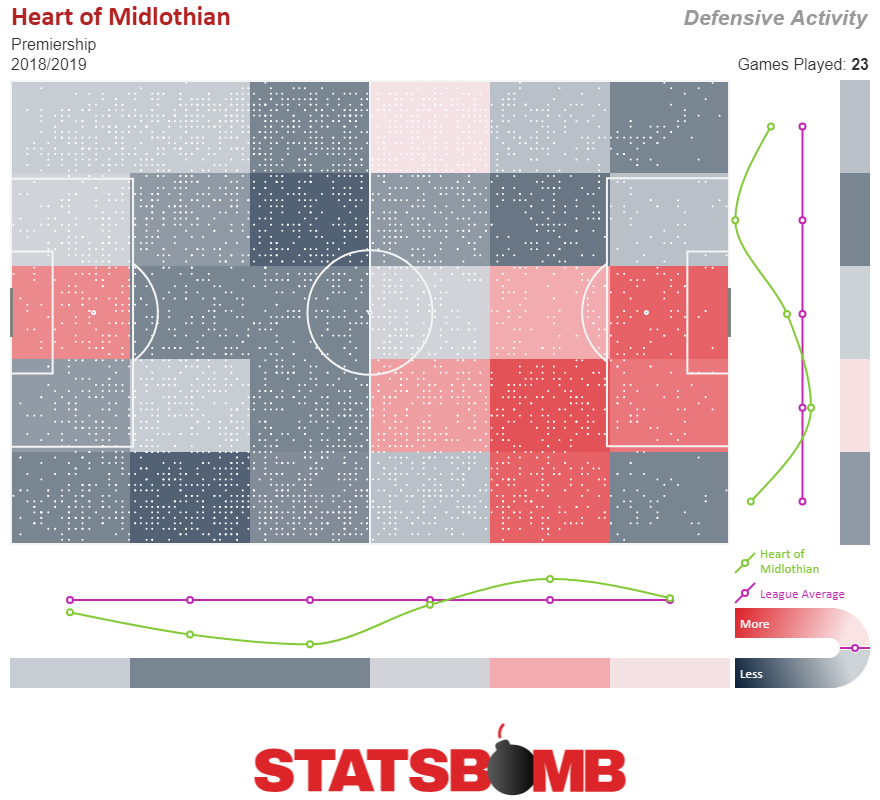
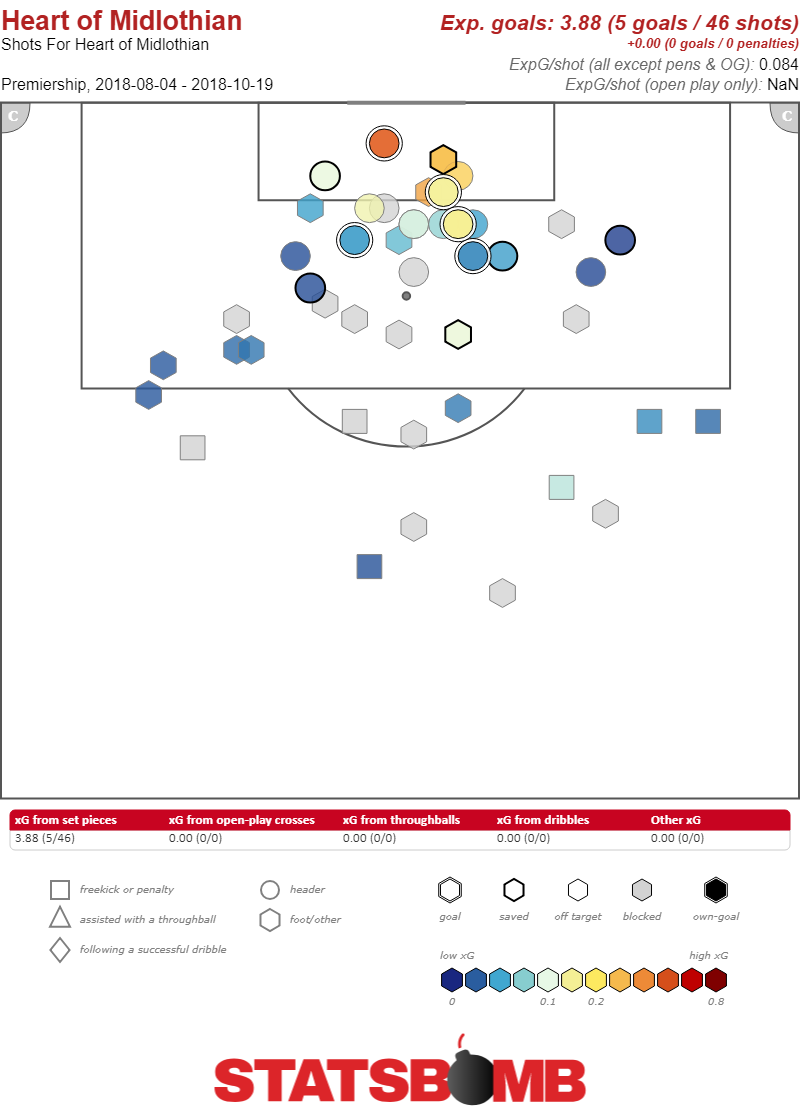
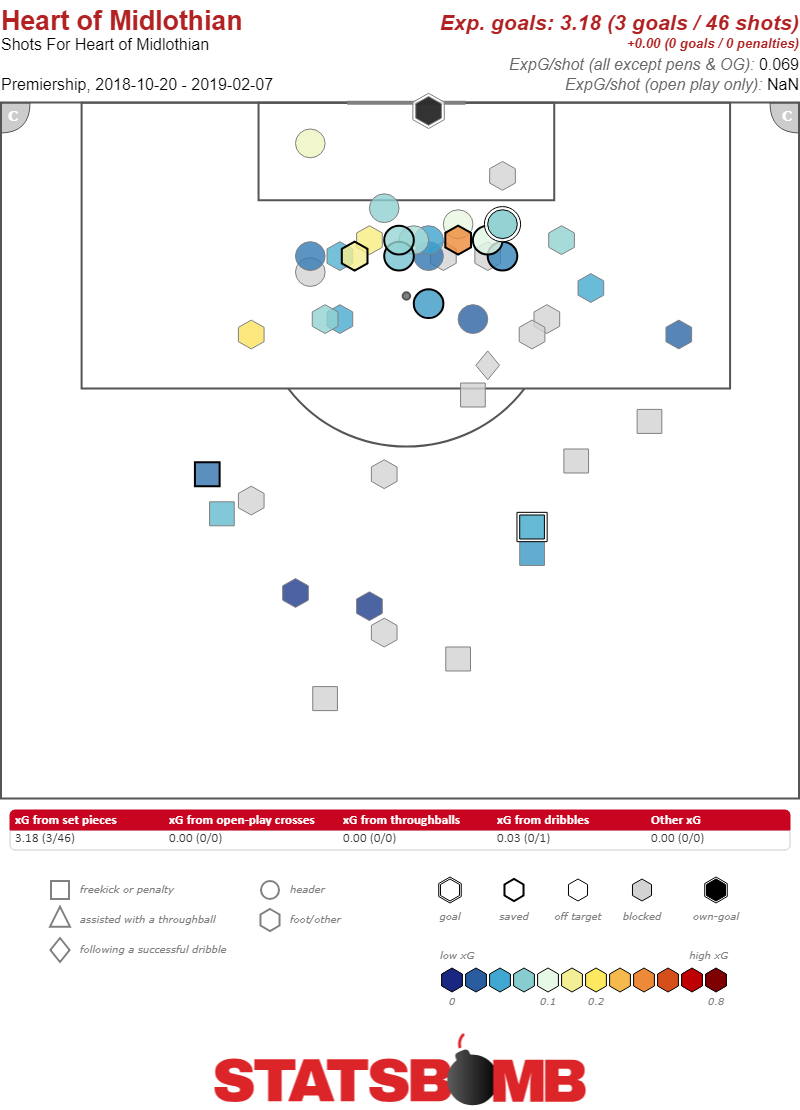 During this period Hearts lost a great deal of intensity and aggression in midfield and also experienced a serious change in their performance from set pieces. After eight weeks of the season they had conceded the lowest xG from set pieces in the league but they have now conceded the fifth highest amount. In the fifteen weeks since that eight week marker they have only been able to double the number of shots from set pieces they had taken. And that more recent set of set piece shots are poorer quality too. Not a shock that a decline in a couple of the areas so key to the Jam Tarts' early success has led to a drop off in results.
During this period Hearts lost a great deal of intensity and aggression in midfield and also experienced a serious change in their performance from set pieces. After eight weeks of the season they had conceded the lowest xG from set pieces in the league but they have now conceded the fifth highest amount. In the fifteen weeks since that eight week marker they have only been able to double the number of shots from set pieces they had taken. And that more recent set of set piece shots are poorer quality too. Not a shock that a decline in a couple of the areas so key to the Jam Tarts' early success has led to a drop off in results. 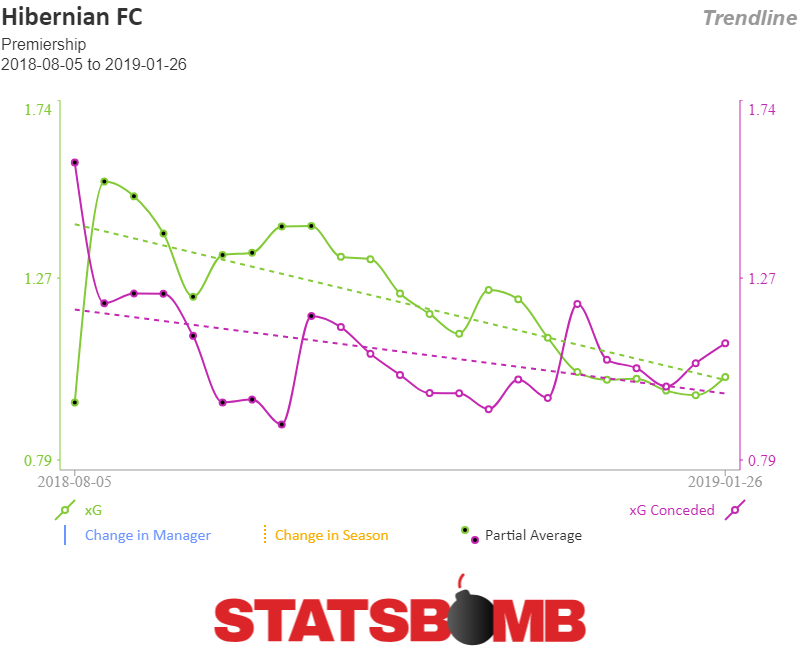 The drop off has been even more pronounced for rivals Hibs. They are now managerless and eleven points behind Hearts. The loss of the entirety of last season's midfield, especially John McGinn's unique blend of grit and glitter, has caught up with them. Add in the departure of ball playing center back Efe Ambrose, the loss of defensive starlet Ryan Porteous to serious injury, rumors of training ground bust-ups and it has been a tough few months.
The drop off has been even more pronounced for rivals Hibs. They are now managerless and eleven points behind Hearts. The loss of the entirety of last season's midfield, especially John McGinn's unique blend of grit and glitter, has caught up with them. Add in the departure of ball playing center back Efe Ambrose, the loss of defensive starlet Ryan Porteous to serious injury, rumors of training ground bust-ups and it has been a tough few months. 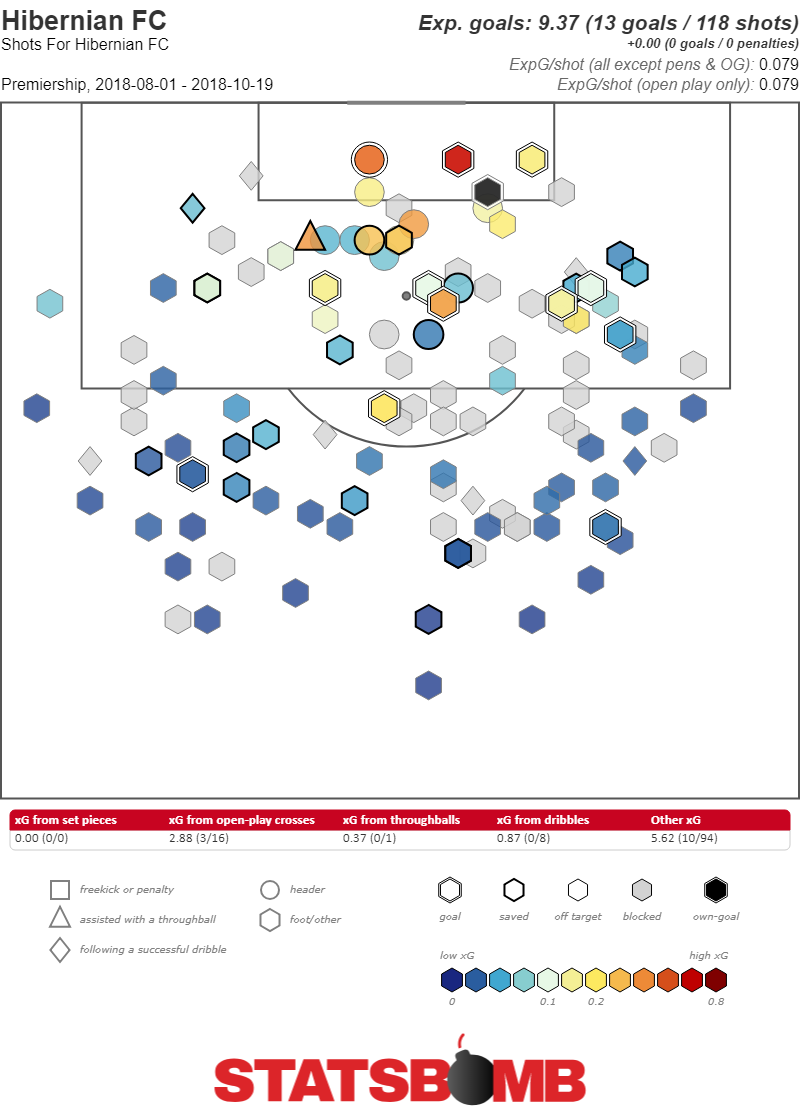
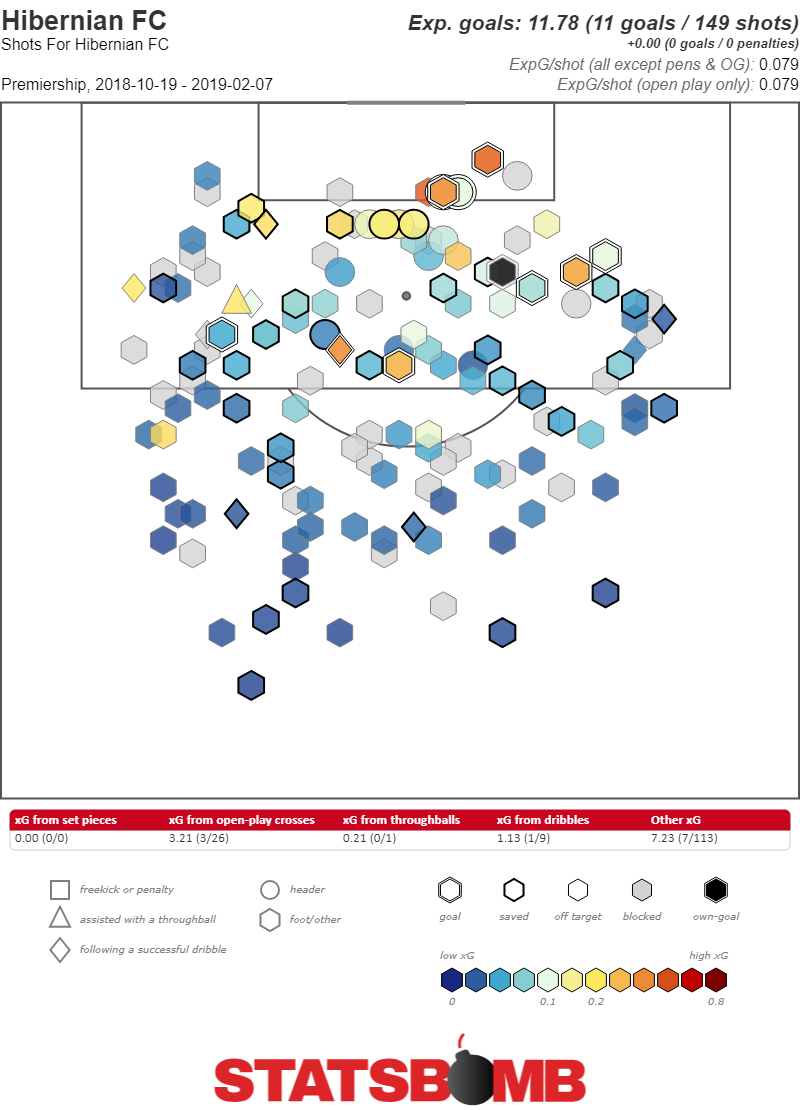 Hibs have been taking fairly mediocre shots from the outset of the season and some early luck in front of goal has dried up. Well, in front of goal is perhaps a little incorrect given the distance that Stevie Mallan attempts pot shots from. In fact, the average distance of a Hibs shot is the third furthest from goal in the league and they take the most shots from outside the box per match.
Hibs have been taking fairly mediocre shots from the outset of the season and some early luck in front of goal has dried up. Well, in front of goal is perhaps a little incorrect given the distance that Stevie Mallan attempts pot shots from. In fact, the average distance of a Hibs shot is the third furthest from goal in the league and they take the most shots from outside the box per match. 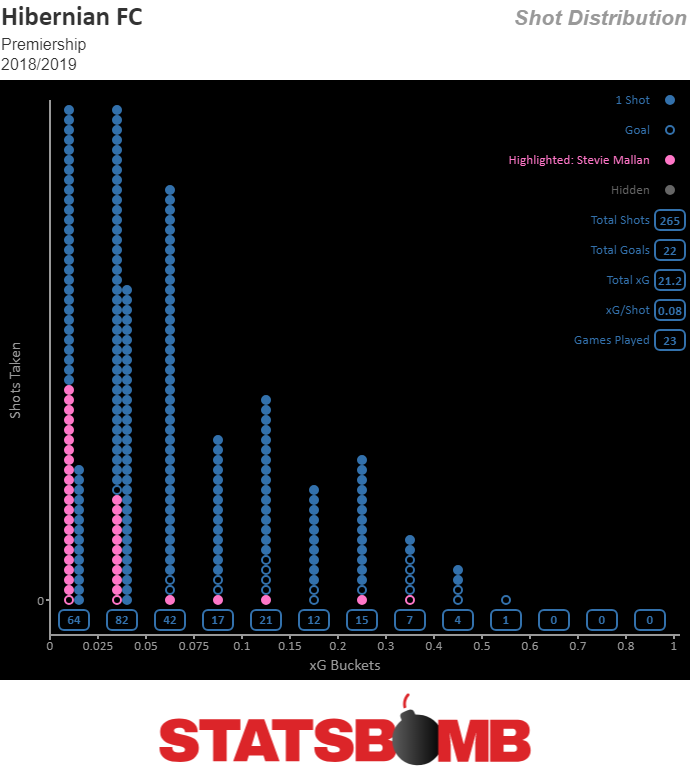 In addition, fewer of their shots since that eight week marker are clear ones at goal or ones straight after winning the ball back in a high press. They're really quite poor at creating good opportunities to score; even their set pieces generate the eighth least xG in the twelve team division. Add in the fact that they are now conceding more shots and significantly more xG on average and it is clear that there is a real lack of sunshine on Leith. While Hearts appear to have turned a corner, are even showing signs of life at set pieces and could be considered to be entering a third act of their season Hibs have lost four of their last five matches and desperately need the renewed sense of direction and fresh tactical ideas a new managerial appointment might bring.
In addition, fewer of their shots since that eight week marker are clear ones at goal or ones straight after winning the ball back in a high press. They're really quite poor at creating good opportunities to score; even their set pieces generate the eighth least xG in the twelve team division. Add in the fact that they are now conceding more shots and significantly more xG on average and it is clear that there is a real lack of sunshine on Leith. While Hearts appear to have turned a corner, are even showing signs of life at set pieces and could be considered to be entering a third act of their season Hibs have lost four of their last five matches and desperately need the renewed sense of direction and fresh tactical ideas a new managerial appointment might bring. 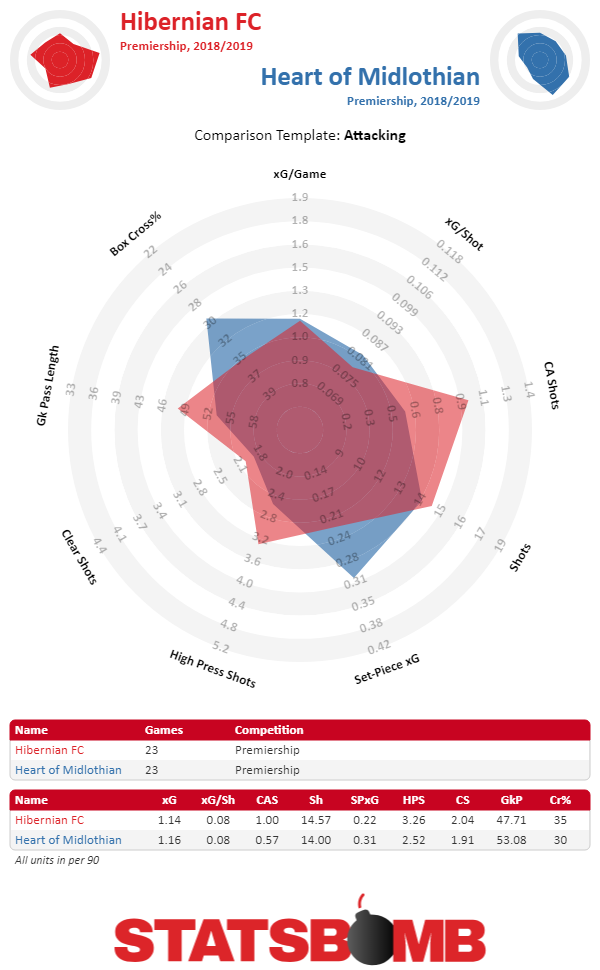
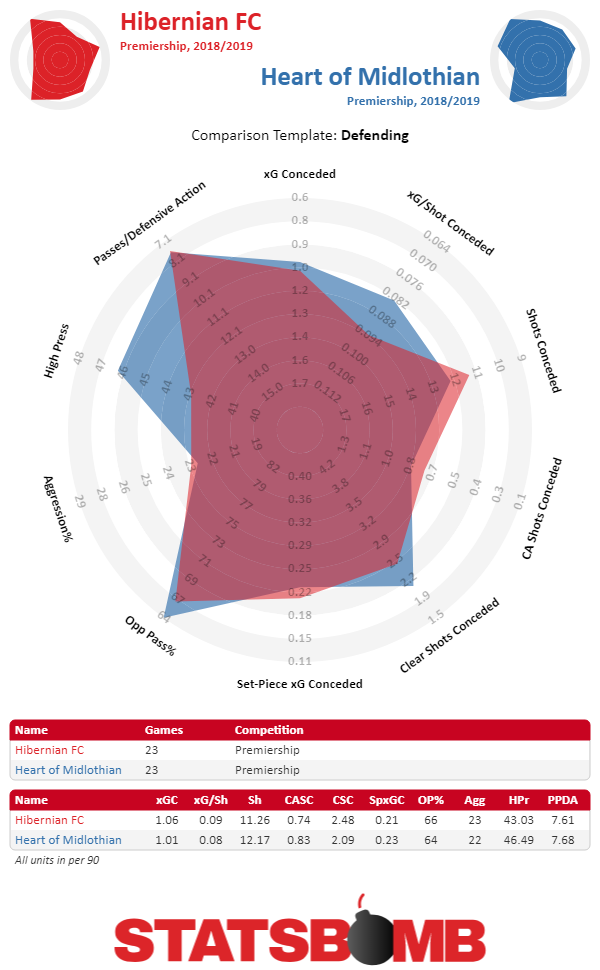
Survival Of The Least Terrible
A positive for Hibs is that at least they cannot get relegated. There are three teams so much worse than everyone else in the Scottish Premiership that their fate has been clear almost from the first kick off. Hamilton Academical, Dundee FC and St Mirren, currently separated by just six points, will finish in the bottom three spots. Dead last will be automatically relegated and the team in eleventh will face a play off with the second placed team in the SPFL Championship. So, who will claw their way to tenth place and survival? 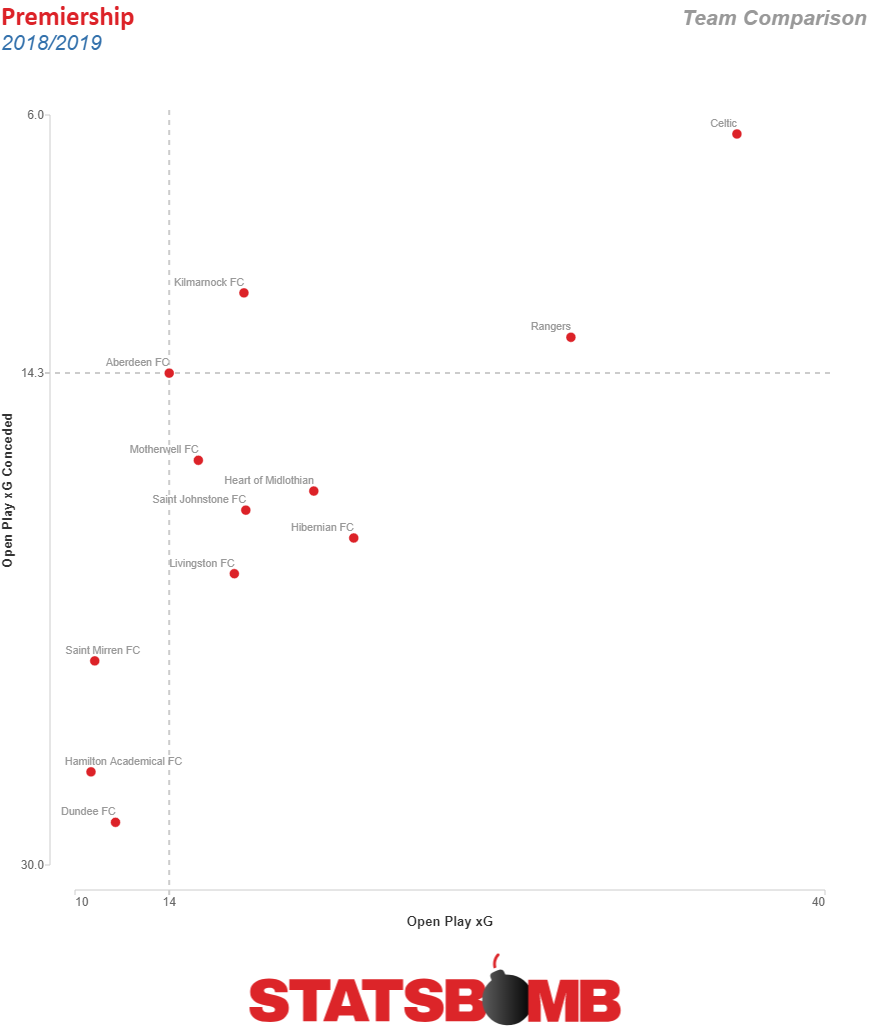 Hamilton have moved into tenth place after a draw and a win in new manager Brian Rice's first two matches. Previous boss Martin Canning had managed the team for four years and if last season's finish outside the relegation spots only on goal difference wasn't a sign that it might be time to move on then the underlying numbers so far this time around certainly were. The Accies take the fewest shots and generate the lowest xG per match in the league. They also concede the most shots, the most xG from set pieces and the second most overall xG per match.
Hamilton have moved into tenth place after a draw and a win in new manager Brian Rice's first two matches. Previous boss Martin Canning had managed the team for four years and if last season's finish outside the relegation spots only on goal difference wasn't a sign that it might be time to move on then the underlying numbers so far this time around certainly were. The Accies take the fewest shots and generate the lowest xG per match in the league. They also concede the most shots, the most xG from set pieces and the second most overall xG per match. 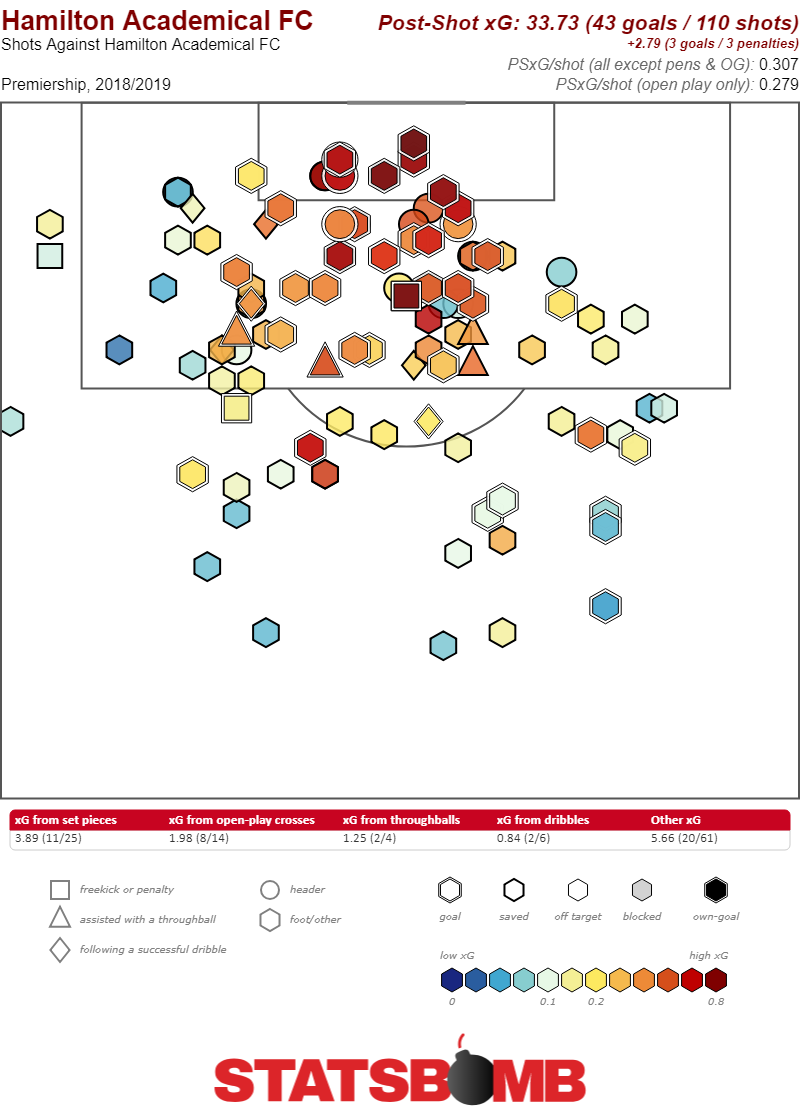
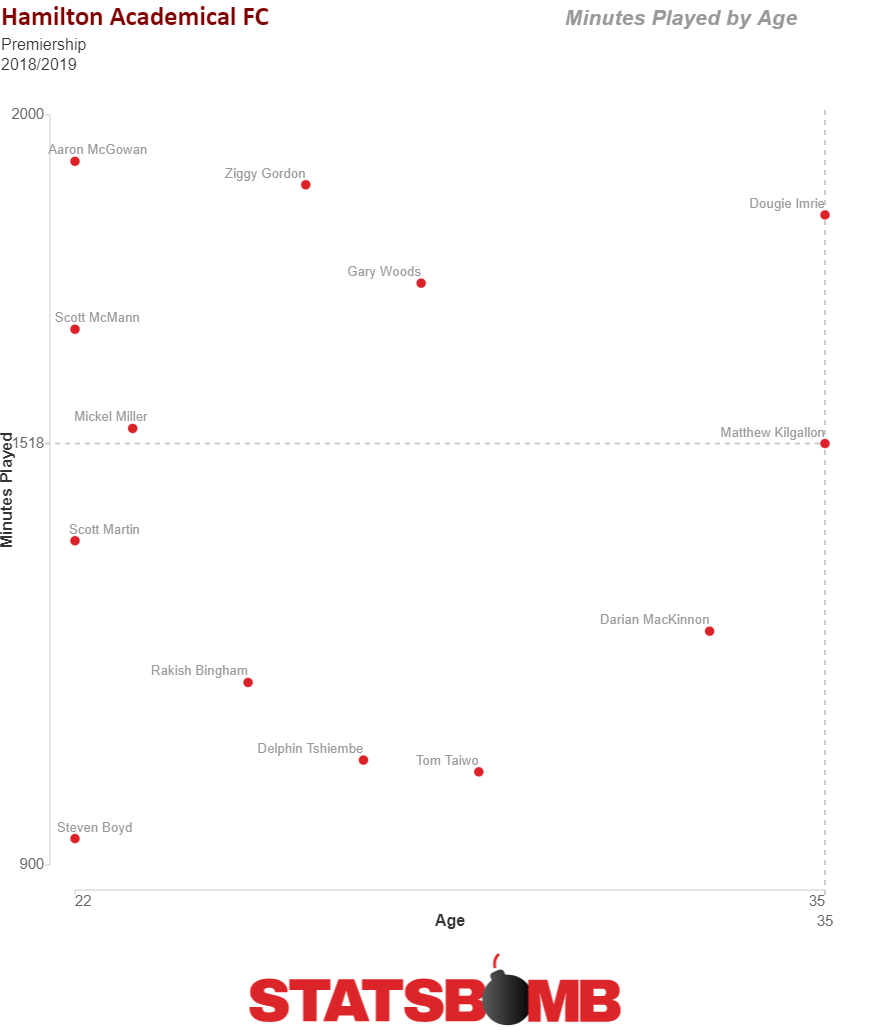 This is a team with real issues all over the pitch. One contributory factor could be the age profile of the squad as an alarmingly low number of minutes have been given to peak age outfield footballers. Hamilton might have had a small upturn in form under their new manager but there is certainly no guarantee their issues are fixed. Their stadium is sponsored by a local medicinal cannabis oil firm and fans might still need hand outs of their chronic pain relief products to get them through the remainder of the season.
This is a team with real issues all over the pitch. One contributory factor could be the age profile of the squad as an alarmingly low number of minutes have been given to peak age outfield footballers. Hamilton might have had a small upturn in form under their new manager but there is certainly no guarantee their issues are fixed. Their stadium is sponsored by a local medicinal cannabis oil firm and fans might still need hand outs of their chronic pain relief products to get them through the remainder of the season. 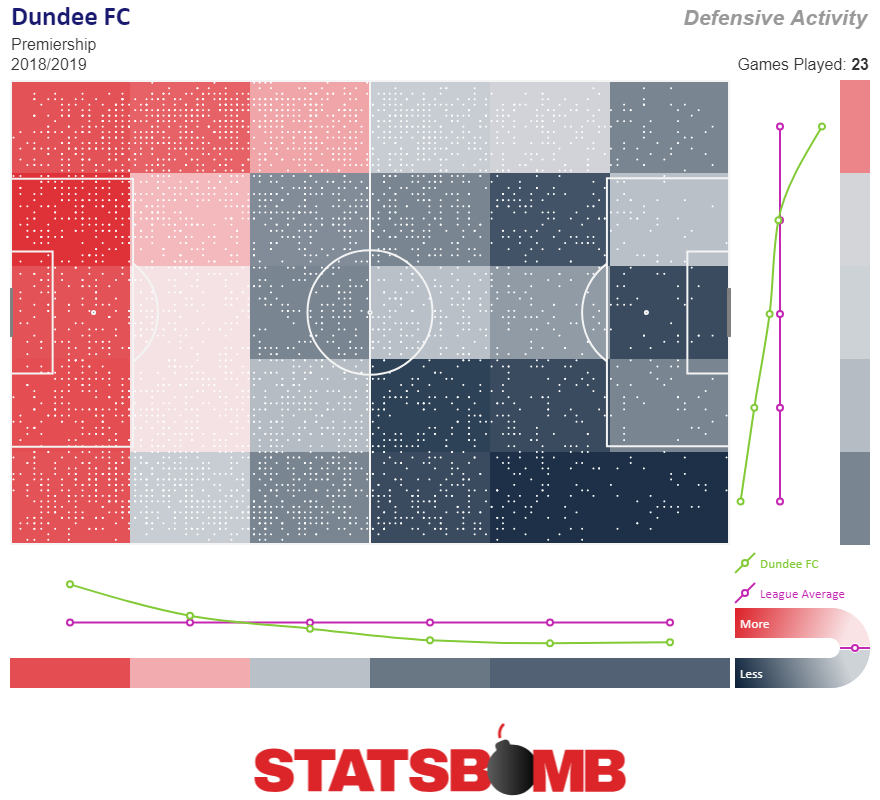 Jim McIntyre may have replaced Neil McCann as Dundee FC manager but they are yet to fully shake off their former boss's style of play. The eleventh placed team make almost twenty fewer aggressive actions than their relegation rivals each match. That lack of aggression until it is too late leads to, no surprise, conceding the second most shots, allowing the highest average xG per shot and giving up the most xG per game in the league. The Dee average 49% of the possession in their matches but having a reasonable share of the ball doesn't seem to help them where it matters. They take the third fewest shots and generate the third lowest xG per match. This team gives up really good chances and just don't have the talent to walk it into the goal at the other end.
Jim McIntyre may have replaced Neil McCann as Dundee FC manager but they are yet to fully shake off their former boss's style of play. The eleventh placed team make almost twenty fewer aggressive actions than their relegation rivals each match. That lack of aggression until it is too late leads to, no surprise, conceding the second most shots, allowing the highest average xG per shot and giving up the most xG per game in the league. The Dee average 49% of the possession in their matches but having a reasonable share of the ball doesn't seem to help them where it matters. They take the third fewest shots and generate the third lowest xG per match. This team gives up really good chances and just don't have the talent to walk it into the goal at the other end. 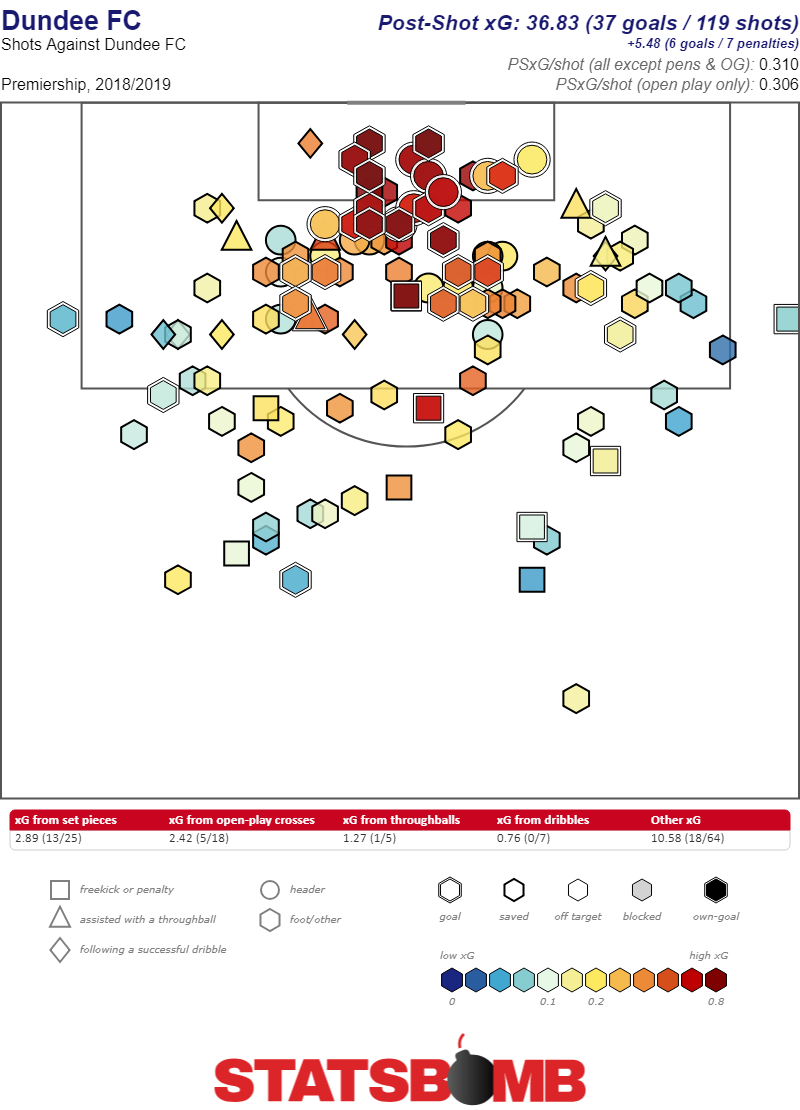 The January additions of goalkeeper Seny Dieng and striker Andrew Nelson could help change Dundee FC's fortunes but fans of the club must be looking at their city's new Victoria and Albert design museum's facade, built to represent Scotland's eastern cliff edges, and picturing their club's precipitous descent to the division below. Dundee may be the city of jute, jam and journalism but Paisley, home to St Mirren, is famous for another kind of print. Paisley Pattern print. The iconic, Kashmiri influenced clothing design features an abstract motif. Is it a fig leaf? An almond? No, come on, those are tear drops. This season St Mirren are on their second manager, their fourth goalkeeper and their fans must have lost track of the number of teeth gnashed, fists clenched, angry words said and, fittingly, tears shed.
The January additions of goalkeeper Seny Dieng and striker Andrew Nelson could help change Dundee FC's fortunes but fans of the club must be looking at their city's new Victoria and Albert design museum's facade, built to represent Scotland's eastern cliff edges, and picturing their club's precipitous descent to the division below. Dundee may be the city of jute, jam and journalism but Paisley, home to St Mirren, is famous for another kind of print. Paisley Pattern print. The iconic, Kashmiri influenced clothing design features an abstract motif. Is it a fig leaf? An almond? No, come on, those are tear drops. This season St Mirren are on their second manager, their fourth goalkeeper and their fans must have lost track of the number of teeth gnashed, fists clenched, angry words said and, fittingly, tears shed. 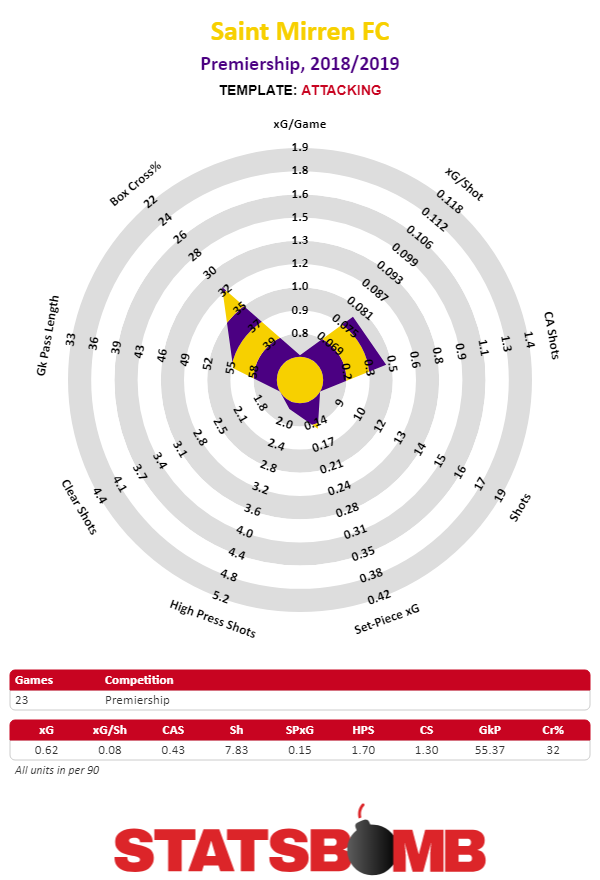 St Mirren are bottom on twelve points and have lost their last six matches. The club from Paisley take the second fewest shots and create the second least xG per match in the league. They lack creativity and any successful methods for progressing the ball up the pitch. As a result they shoot, on average, a whopping 19.06 meters away from goal.
St Mirren are bottom on twelve points and have lost their last six matches. The club from Paisley take the second fewest shots and create the second least xG per match in the league. They lack creativity and any successful methods for progressing the ball up the pitch. As a result they shoot, on average, a whopping 19.06 meters away from goal. 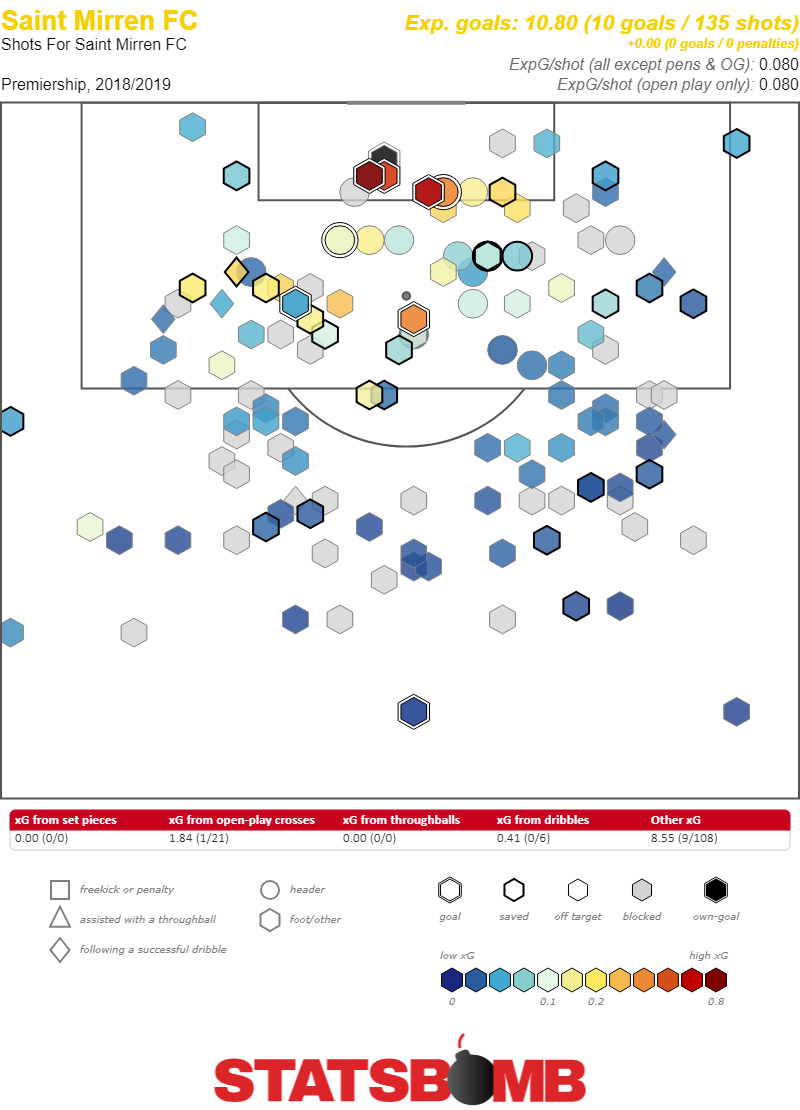 The Buddies concede the fourth most shots per match and the third most xG on average. While this is better than their relegation rivals there has been a lack of any sort of improvement in those underlying numbers throughout the season whereas Dundee FC and Hamilton have shown a capability to do better at times. Unless some of St Mirren's January transfer window additions can make a major difference, and keep in mind that they have already tried out forty different players this season, automatic relegation seems likely. More Paisley pattern shaped tears are yet to come. My feeling is that Dundee FC will rise to tenth and Hamilton will land in the play off spot.
The Buddies concede the fourth most shots per match and the third most xG on average. While this is better than their relegation rivals there has been a lack of any sort of improvement in those underlying numbers throughout the season whereas Dundee FC and Hamilton have shown a capability to do better at times. Unless some of St Mirren's January transfer window additions can make a major difference, and keep in mind that they have already tried out forty different players this season, automatic relegation seems likely. More Paisley pattern shaped tears are yet to come. My feeling is that Dundee FC will rise to tenth and Hamilton will land in the play off spot.
Valencia A Pressing Concern For Celtic
Celtic have won five league matches in a row since their Old Firm derby defeat late last year, building up a six point lead over second placed Rangers in the process. That points difference is underpinned by an average xG difference per game which is significantly superior to that of any of their domestic challengers. The Hoops are taking an average of almost twenty shots in each match and their miserly defense is giving up an average of just 0.47 xG each time they play. It may be early February but Celtic are well on course to clinch their eighth Scottish Premiership title in a row. 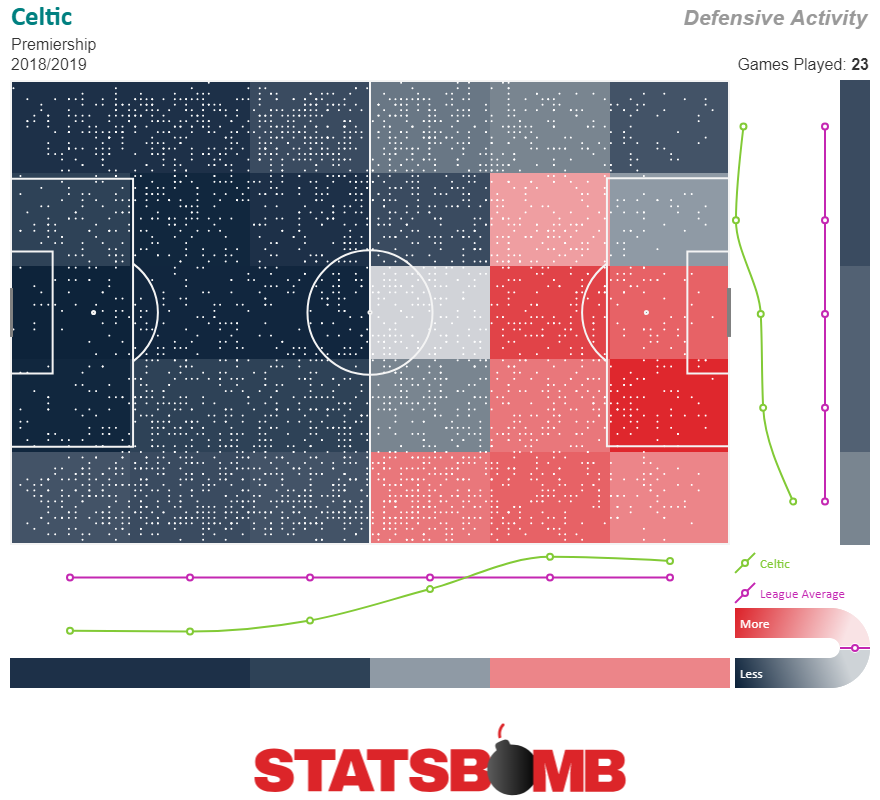
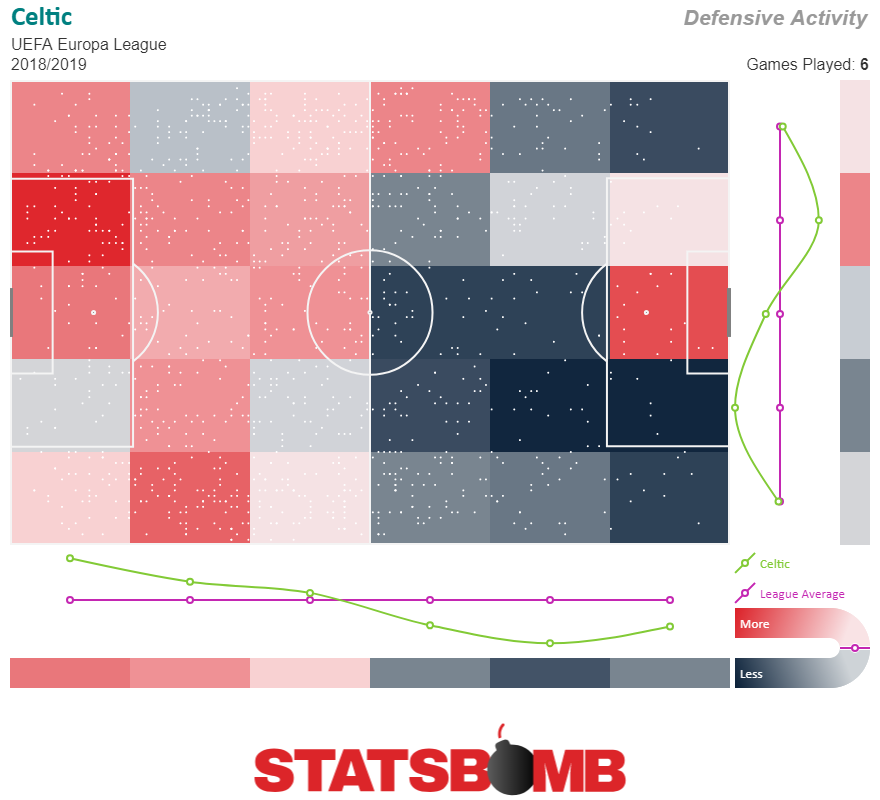 Europe has, naturally, been a different and tougher proposition for Celtic. Just look at the contrast between those defensive activity maps. In their Europa League group they were pressed smartly and aggressively by Red Bull Salzburg and RB Leipzig, in a way they just don't experience in Scotland. Celtic managed an average of just ten shots per match and finished the group stage with a negative xG difference on average. However, they made it through - underlying stats be damned - thanks in part to a Rosenberg victory over RB Leipzig on the final match day. Next week the Glasgow club face Valencia CF in the first leg of the round of 32.
Europe has, naturally, been a different and tougher proposition for Celtic. Just look at the contrast between those defensive activity maps. In their Europa League group they were pressed smartly and aggressively by Red Bull Salzburg and RB Leipzig, in a way they just don't experience in Scotland. Celtic managed an average of just ten shots per match and finished the group stage with a negative xG difference on average. However, they made it through - underlying stats be damned - thanks in part to a Rosenberg victory over RB Leipzig on the final match day. Next week the Glasgow club face Valencia CF in the first leg of the round of 32. 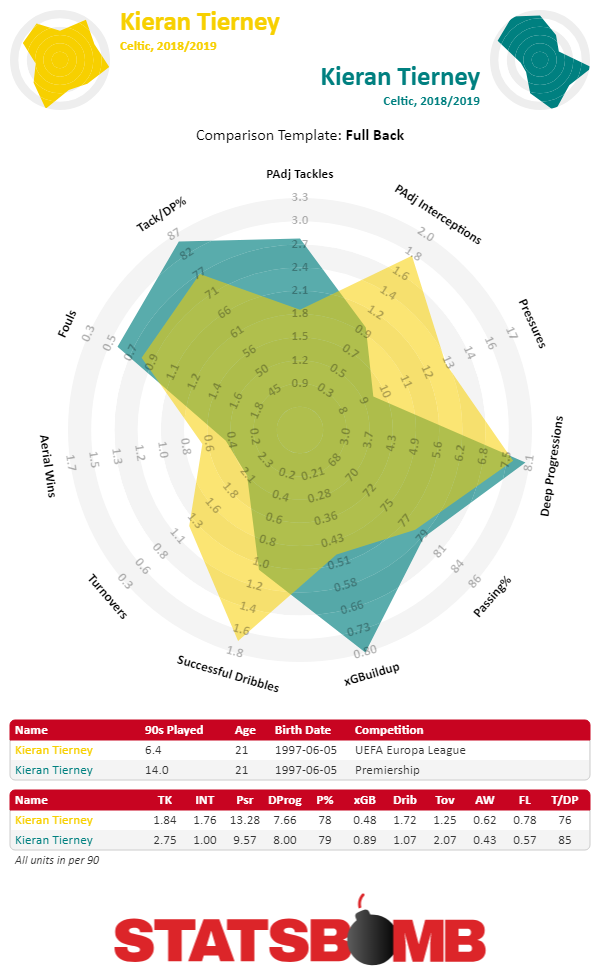 Celtic are in the midst of a bit of an injury crisis with Filip Benkovic, Olivier Ntcham, Odsonne Edouard, Tom Rogic, James Forrest and Kieran Tierney sidelined. Manager Brendan Rodgers was optimistic after the midweek victory against Hibernian that a few of those players would be available for the Valencia match and, despite that lengthy queue at the treatment table, there is a groundswell of optimism around Celtic Park. Five wins with five clean sheets in a row will do that for you. There's also been the small matter of some exciting January transfer window incomings. Timothy Weah and Oliver Burke have added pace, directness, pressing and goals while the arrival of Jeremy Toljan on loan from Borrusia Dortmund adds, well, a right back that can do normal right back things: get forward at speed, stretch defenses to create chances and not add unduly to Scott Brown's defensive workload. He might not be the long term replacement for Mikael Lustig that Celtic desperately need but he could be a game changer for the remainder of this season.
Celtic are in the midst of a bit of an injury crisis with Filip Benkovic, Olivier Ntcham, Odsonne Edouard, Tom Rogic, James Forrest and Kieran Tierney sidelined. Manager Brendan Rodgers was optimistic after the midweek victory against Hibernian that a few of those players would be available for the Valencia match and, despite that lengthy queue at the treatment table, there is a groundswell of optimism around Celtic Park. Five wins with five clean sheets in a row will do that for you. There's also been the small matter of some exciting January transfer window incomings. Timothy Weah and Oliver Burke have added pace, directness, pressing and goals while the arrival of Jeremy Toljan on loan from Borrusia Dortmund adds, well, a right back that can do normal right back things: get forward at speed, stretch defenses to create chances and not add unduly to Scott Brown's defensive workload. He might not be the long term replacement for Mikael Lustig that Celtic desperately need but he could be a game changer for the remainder of this season. 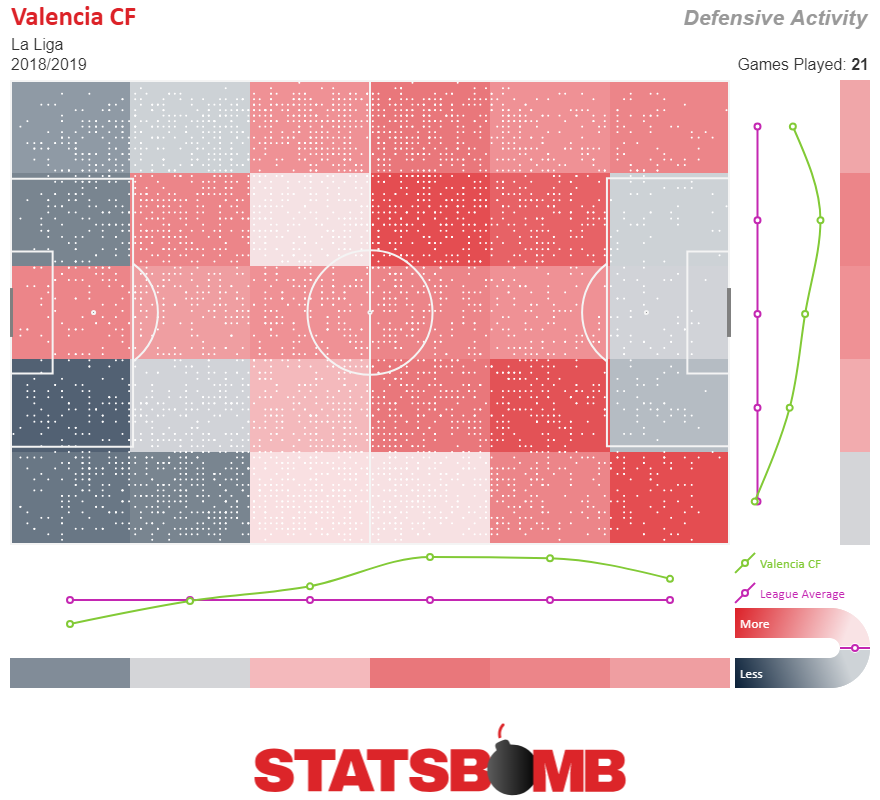 Celtic's fullbacks could be very important against Valencia given the Spanish side's normal approach is to deploy a 4-4-2 formation and apply pressure high up on both flanks. On the right Carlos Soler has added a great deal of industry to his game this season and is making almost six pressure regains every match. Further danger to Celtic could arise from center forward Rodrigo Moreno, a capable dribbler with good shot locations, and playmaker captain Dani Parejo who makes almost ten deep progressions each game. Santi Mina is another dangerman, particularly when he is inspired to play aggressively, but he does lose the ball fairly often and Celtic could pinpoint these turnovers as a starting point for counter attacks. Scotland's champions might also find that, although Valencia do not give away many clear shots at goal, they may be able to exploit space behind center back Ezequiel Garay if he is drawn forward and win high balls against the less aerially dominant Mouctar Diakhaby.
Celtic's fullbacks could be very important against Valencia given the Spanish side's normal approach is to deploy a 4-4-2 formation and apply pressure high up on both flanks. On the right Carlos Soler has added a great deal of industry to his game this season and is making almost six pressure regains every match. Further danger to Celtic could arise from center forward Rodrigo Moreno, a capable dribbler with good shot locations, and playmaker captain Dani Parejo who makes almost ten deep progressions each game. Santi Mina is another dangerman, particularly when he is inspired to play aggressively, but he does lose the ball fairly often and Celtic could pinpoint these turnovers as a starting point for counter attacks. Scotland's champions might also find that, although Valencia do not give away many clear shots at goal, they may be able to exploit space behind center back Ezequiel Garay if he is drawn forward and win high balls against the less aerially dominant Mouctar Diakhaby. 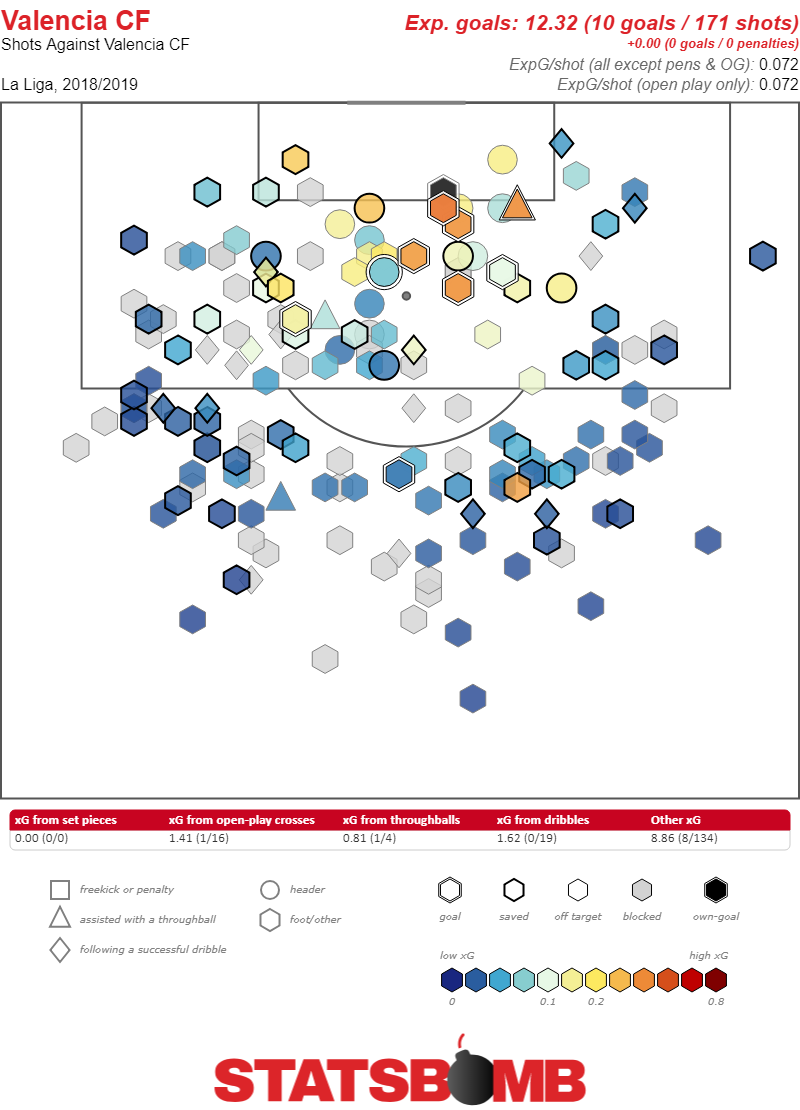 Valencia have had a strange season in La Liga. They had only won four games by the start of January and even now are down in eight place. So far things haven't quite worked out in front of goal; they have only scored fifteen times from open play whereas they've created an open play xG of 24. They have been accused of not seizing the initiative in games and manager Marcelino has faced criticism for not being able to evolve the team successfully from last season. However, they create the second highest average xG and concede the lowest average xG per match and have the second best average xG difference in the league!
Valencia have had a strange season in La Liga. They had only won four games by the start of January and even now are down in eight place. So far things haven't quite worked out in front of goal; they have only scored fifteen times from open play whereas they've created an open play xG of 24. They have been accused of not seizing the initiative in games and manager Marcelino has faced criticism for not being able to evolve the team successfully from last season. However, they create the second highest average xG and concede the lowest average xG per match and have the second best average xG difference in the league! 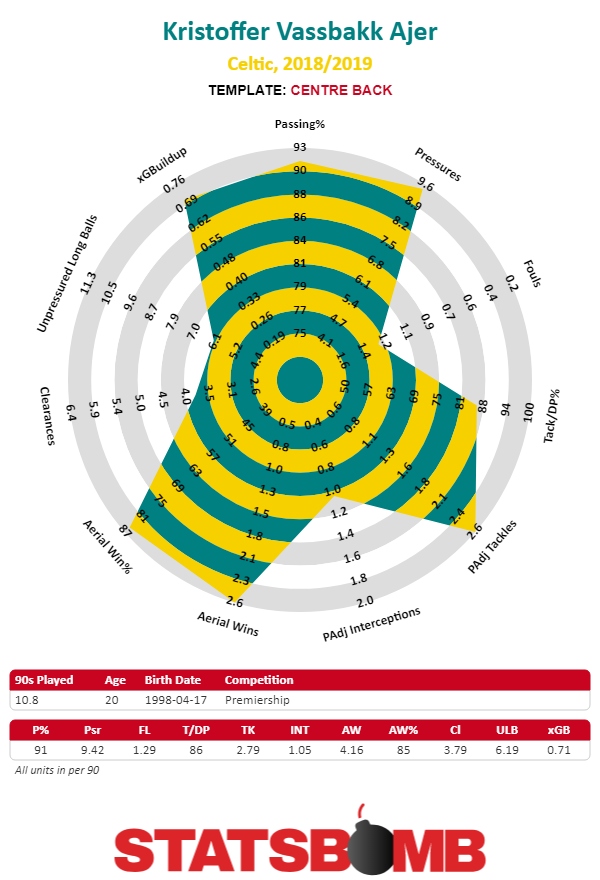 All those underlying stats underline the fact that Los Che are high quality opposition for Celtic to face. If Rodgers continues with the selection of Scott Bain instead of Craig Gordon in goal his superior ability with the ball at his feet should assist the Hoops backline in coping with Valencia's pressure. In addition, Kristoffer Ajer will need to move on quickly from the red card he received after being caught in possession against St Johnstone and be ready to evade the press with passes and dribbles out of defense. Add the electric, in form, Weah to the mix and this match, one of the few remaining ones likely to challenge Celtic this season, could be yet another historic European victory for the Hoops.
All those underlying stats underline the fact that Los Che are high quality opposition for Celtic to face. If Rodgers continues with the selection of Scott Bain instead of Craig Gordon in goal his superior ability with the ball at his feet should assist the Hoops backline in coping with Valencia's pressure. In addition, Kristoffer Ajer will need to move on quickly from the red card he received after being caught in possession against St Johnstone and be ready to evade the press with passes and dribbles out of defense. Add the electric, in form, Weah to the mix and this match, one of the few remaining ones likely to challenge Celtic this season, could be yet another historic European victory for the Hoops.